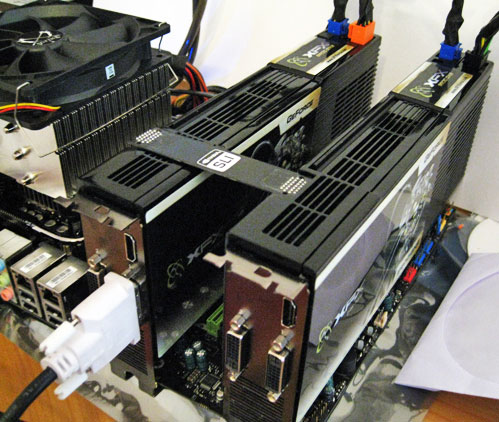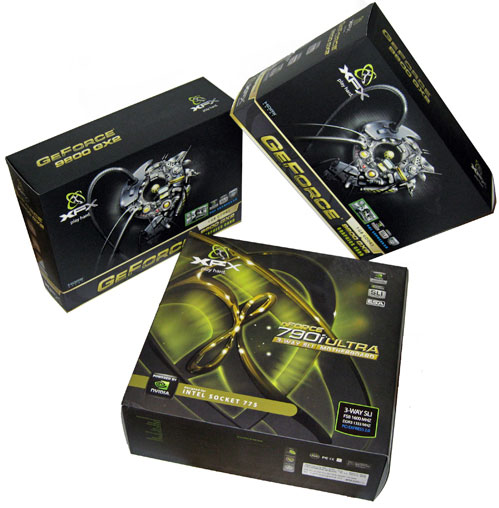Review: Ultra in a dust cloud
A few days ago we talked about XFX's 9800 GX2 and now it's time to get back to it, this time around pitted against the 8800 Ultra. The 9800 GX2 is a stunning card and it assures Nvidia bragging rights for months to come. It outperforms the Ultra all the way to the retirement home, making way for Nvidia's ninth generation.
The XFX 9800 GX2 is a reference designed card with reference clocks. Its GPUs run at 600MHz, the Shaders are clocked at 1500MHz and the Gigabyte of memory runs at 1000MHz (2000MHz effectively). Like all other partners, XFX is currently offering only the reference card, but we're expecting to see some overclocked cards on the market pretty soon.

Thanks to its huge, black metal case and the Borg-esque "9" on the sticker the XFX card looks pretty mean. The tentacles on the "9" are looking for an acquaintance in the form of another 9800 GX2 card. Quad-SLI is going to push gaming in the ultra high-end to a whole new level. We still can't write much about Quad-SLI, as the NDA is in force until March 25. All we can say is that it works and scales well.
We showed you the picture a few days ago, but in case you've missed it, here it is again. An XFX flavored Quad-SLI setup on a 790i Ultra motherboard, also from XFX. Looks nice, doesn't it ?

We will jump to benchmarking now, as we've described the new 9800 GX2 in detail in our previous reviews. In short, it consists of two G92 GPUs working in tandem, thanks to AFR SLI technology. The new card retains all the good sides of the G92 GPU, but thanks to the dual GPU design the card has a total of 256 stream processors, 1GB of memory, 1508 million transistors, etc. Double the numbers, double the fun. Best of all, we end up with a single dual slot card which provides you with as much performance as two dual slot 8800 GTS cards in SLI.
By combining two 9800 GX2 cards you'll get Quad-SLI, sticking two 8800 GTS cards into your rig on the other hand will get you just plain SLI. This is what makes this card different and keeps it one step ahead of other G92-based products. XFX's 790i Ultra has three PCI Express slots, which means that we can install three Geforce cards in a Tri-SLI setup. The upcoming 9800 GTX is the first card to support Tri-SLI, but it's possible that the 9800 GT will also feature Tri-SLI support. Nvidia's 790i chipset is the first to feature DDR3 support.
Thanks to XFX, who were kind enough to send us a 790i Ultra motherboard along with 9800 GX2 cards, we were able to change our testbed. Apart from using DDR3 memory, we also installed Vista x64. Our first 9800 GX2 reviews were done with Windows XP and we were curious to find out how the new card performs under Vista. Both Nvidia and ATI are turning to Vista and XP is slowly going into retirement.

Results

3Dmark 05 shows an advantage of 8 percent, while the 3Dmark 06 results are 22 percent higher. In games, the 9800 GX2 is even faster, so both of these marks just don't do it justice.

In World in Conflict the 9800 GX2 is 15 to 23 percent faster than the Ultra.

At 1920x1200 the XFX 9800 GX2 is 26 percent faster. At lower resolutions the difference is even bigger, jumping to 65 percent.

The 9800 GX2 is 21 to 30 percent faster.

At 1280x1024 the GX2 is 37 percent faster and at the highest tested resolution the advantage is even greater, 57 percent. In spite of that, 1920x1200 is still not playable on these cards. Without AA at 1600x1200 the Ultra scores 53 percent less.

Apart from 1600x1200 without AA, XFX 9800 GX2 is more than 60 percent faster than the 8800 Ultra. At 1600x1200 it's "just" 51 percent faster, which is still an impressive score.

Unlike Call of Juarez, Half Life Episode 2 did not utilize the dual GPU card's potential. Only at the highest resolution we can see that the 9800 GX2 is much more powerful, as it scores 45 percent more.
Conclusion:
XFX 9800 GX2 clearly outperforms the 8800 Ultra. It is about 25 percent more expensive than the Ultra, but it scores at least 25 percent more. As you can see, all games except Crysis are playable at 1920x1200 with 4x AA and 8x Aniso. It's a dual slot card and it can be installed in all chassis capable of dealing with other dual slot solutions.
Although there was much talk about this card's heat, we believe that it's not a major issue. The GPUs don't ever go over 82°C, but it will dissipate a lot of heat, so it's best to invest in some case cooling just as a precaution. Thanks to its stunning performance, we can easily recommend XFX's 9800 GX2 and any 9800 GX2, for that matter.
